Kinds Of Noun - Class 6 PDF Download
The Noun
All the things in the world fall into two classes:
- Things that have material bodies. Such things are called concrete things.
- Things that have no material bodies. Such things are called abstract things.
Accordingly, nouns also fall into two main classes:
- Concrete Nouns.
- Abstract Nouns.
Kinds of Concrete Nouns
- The Proper Noun: A Proper Noun is the name of a particular person, place or thing. When you write a proper noun, remember to begin it with a capital letter.
Examples:
(i) Pushpender (name)
(ii) Indira Gandhi (name/leader)
(iii) Delhi (city)
(iv) Aurangabad (village/town)
(v) The Red Fort (Historical building)
(vi) Taj Express (train)
(vii) Pushpak (aeroplane)
(viii) Haryana Roadways (bus)
(ix) Vikrant (ship)
(x) The G.T. Road (road) - The Common Noun: A Noun which does not point out any particular person, place or thing, but is common to all persons or things of the same class or kind is called Common Noun.
Examples:
(i) Persons: Boy, girl, man, woman, teacher, doctor, peon etc.
(ii) Animals: Dog, cat, ant, fly, mouse, elephant, wasp etc.
(iii) Place: Village, city, town, state, country, school, park, zoo etc.
(iv) Things: Pen, book, bag, bed, needle, table, spoon, bat etc. - The Collective Noun: A Collective Noun is the name of a group or collection of persons, animals, or things taken together and spoken of as one whole.
Examples:
(i) Collection of persons: Army, class, team, party, mob, crowd etc.
(ii) Collection of animals: Flock, herd etc.
(iii) Collection of things: Bunch, heap, dozen, score, bundle etc. - The Material Noun: A Material Noun is the name of the matter or substance of which other things are made; as—plastic, glass, paper, rubber, water, milk, butter, oil, ghee, ice, sugar, bread, wheat, china, leather, clay, gold, silver, iron, steel, cotton, wool, nylon, etc.
The Abstract Noun
An Abstract Noun is the name of state, quality, action or feeling or an idea that we can only think of or feel but cannot touch or see. Abstract nouns include names of arts, subjects and features etc.
Examples:
(i) Laughter is the best medicine. (action of laughing)
(ii) Goodness pays in the long run. (quality of being good)
(iii) Childhood is the rosy period of life. (state of being child)
(iv) Real happiness is rare in the world. (feeling of being happy)
(v) Beauty needs no ornaments. (feature of being beautiful)
(vi) Pushpender is well up in English. (name of subject)
(vii) Music and painting are fine art. (names of arts)
The Noun: Numbers
- Countable Nouns: Countable Nouns are the things we can count; as, pens, books, bags, chairs, tables, apples, benches, etc. A singular countable noun always takes a or an before it. We can use a countable noun in the singular and also in the plural; as, This is a pen. These are pens. That is an apple. Those are apples.
- Uncountable Nouns: Uncountable Nouns are the things we cannot count; as, butter, ghee, honey, tea, wool, air, water, milk, oil etc. We never use a or an before an uncountable noun and we don’t use an uncountable noun in the plural; as, we can say two pens but we can’t say two water. We can use some with an uncountable noun. We can use some with a countable noun in the plural; as, Please give me some biscuits. Please give me some milk.
Rules for the Change of Numbers
The nouns which end in ‘s’ or ‘es’ in the plural form are regular plurals. The regular plurals are formed in the following ways:
- By adding the letter ‘s’ to the noun in singular; as, apple – apples, bag – bags, cat – cats, etc.
- Nouns ending in s, ss, sh, ch, x or z form their plurals by adding – ‘es’ to the singular; as, bush – bushes, bus – buses, glass – glasses, etc.
- If a Singular Noun ends in y with a vowel before it, the plural is formed by adding s only; as, Boy – Boys, Bay – Bays, Chimney – Chimneys, Donkey – Donkeys, etc.
- If the Singular Noun ends in f or fe the plural is formed by changing f or fe into v and then adding es; as, Calf – Calves, Elf – Elves, Half – Halves, Knife – Knives, etc.
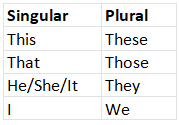
Rules for Making Plural Nouns
Consider the following rules while make a singular noun to plural:
- If Singular Noun ends in y and there is a consonant before y the plural is formed by changing y into i and adding es; as, Army – Armies, Assembly – Assemblies, Baby – Babies, etc. Similarly we can change the following: Country, city, cry, copy, dairy, diary, duty, enemy, fairy, fly, fury, gallery, gully, history, hobby, lady, lorry, lilly, luxury, penny, pony, policy, sky, story, victory.
- If the Singular Noun ends in ief, ff, ef, or f then the plural is formed by adding s to them; as; Belief – Beliefs, Chief – Chiefs, Cliff – Cliffs, Dwarf – Dwarfs, etc. Similarly we can do for the following: Handker-chief, hoof, mischief, gulf, grief, proof, roof, safe, serf, staff, strife, brief, etc.
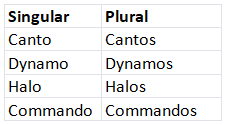
Irregular Plural
The nouns which do not form their plurals by adding s or es are called irregular plurals.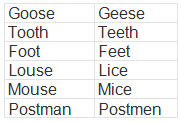
Plural of Compound Nouns
If the Compound Noun is made of two nouns, the second noun is changed into the Plural Form; as, Foot-man: Foot-men, Governor-General: Governor- Generals, Step-son: Step-sons, Step-daughter: Step-daughters, Gentle-man: Gentle-men, Maid-Servant: Maid Servants, etc.
Noun Genders: Ways of Changing Gender
- Words change from masculine to feminine by adding a suffix:
For example: author: authoress and heir: heiress. - Words change from feminine by adding–ess with some changes to the masculine.
For example: Waiter: Waitress, duke: duchess. - Some masculine words change entirely as they become feminine words.
For example: king: queen, bride: groom. - Some masculine words change party when they become feminine words.
For example: Landlord: landlady, milkman: milkmaid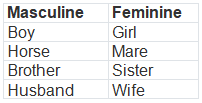
Name of Person
Common Gender is applied to names of persons that do not indicate their sex.
Persons: Baby, child, cousin, friend, infant, cook, student, enemy, neighbour, pupil, person, people, painter, servant, guest, cousin, client, advisor, singer, teacher, pilot, professor, manager etc. 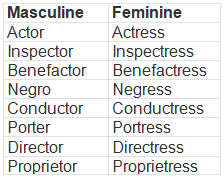
Name of Animals
Common Gender is applied to names of animals that do not indicate their sex.
Animals: Animal, bird, cat, fish, lamb, mouse, rat, ant, worm, frog, snake, sparrow, elephant.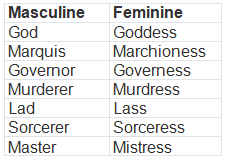
Noun Cases
The Noun: Subjective Case
For example:
(i) Akshay was a good boy.
(ii) The cow is a useful animal.
(iii) She lights a lamp.
(iv) The stone fell from above.
In the above sentences, the words Akshay, The cow, She, The stone are the subjects of the verbs was, is, lights, and fell respectively. They are said to be in the Nominative or The Nominative Case in a sentence can be found by asking the question Who? Which? or What? to the verb. Who was a good boy? – Akshay. Which is a useful animal? – The Cow. Who lights a lamp? – She. What fell? – The stone. Hence Ram, She, The cow, The stone are in the (Nominative or Subjective Case)
The Noun: Objective Case
For example:
(i) Rohit bought a watch.
(ii) Aman hated Mohit.
In the above sentences a watch and Yogesh are the objects of the verbs bought and hated respectively they are said to be in the Objective Case or Accusative Case. Objective Case can be found out by putting the question Whom? or What? after the Verb. What did Rohit buy? – A watch Whom did Aman hate? – Mohit Hence a watch and Mohit are in the Objective Case or Accusative Case. Ram and Yogesh can reverse or exchange their cases when the same sentence is written in the Passive Voice, e.g. Yogesh was hated by Ram. Here Yogesh and Ram are in the Nominative and Accusative Case respectively.
Some verbs like—teach, tell, give, ask, offer, promise take two objects after them. One of these objects refers to some person (living); the other refers to some thing (non-living).
For example:
(i) The teacher taught us English.
(ii) Mother gave the beggar a rupee.
In sentence 1, us and English are both objects of the verb taught. ‘Us’ is the Indirect Object and ‘English’ the Direct Object. In sentence 2, the beggar and a rupee are both objects of the verb gave. Beggar is the Indirect Object and rupee the Direct Object.
The Noun: Dative Case
(i) Vikrant gave Khushi a book.
(ii) The teacher asked Harshit a question.
The Direct object is the first sentence is book and in the second sentence it is question. While the Indirect Object in the first sentence is Khushi, in the second it is Harshit. Hence they are in the Dative Case. The position of the Dative Case (Indirect Object) is immediately after the verb or after the Direct Object following a Preposition.
The Noun: Vocative Case
Come here, boys. Naresh, listen to me. In the above sentences, boys and Naresh are the names of the persons spoken to or addressed. They are, therefore, said to be in the Vocative Case. The Vocative Case is also called the Nominative of Address.
The Noun: Possessive Case
A noun in the Possessive Case is the possessor of the thing. He is Mohan’s father. This is Sita’s book. To find the possessive case put the question—whose? Whose father? – Mohan Whose book? – Sita. The Possessive Case does not always denote possession. It is used to denote authorship, origin, kind etc.
Formation of the Possessive
The letter s is omitted in a few words where too many hissing sounds would come together; as, for conscience’ sake, for goodness’ sake, for justice’ sake, for Jesus’ sake, the Moses’ laws.
- When the noun is plural, and ends in s, the Possessive Case is formed by adding only an apostrophe.
- When the noun in Plural does not end in s, the Possessive sign is formed by adding s.
- When a noun or a title consists of several words, the possessive sign is attached only to the last word.
- When two nouns in apposition, the possessive sign is put to the latter only.
- Also when two nouns are closely connected, the possessive is put to the latter.
- Each of two or more connected nouns implying separate prossessions must take the possessive sign.



















